Disclosure: Meeple Mountain received a free copy of this product in exchange for an honest, unbiased review. This review is not intended to be an endorsement.
I was starting to sweat just a tad.
My buddy John and I were doing a two-player game of SETI: Search for Extraterrestrial Intelligence (2024, Czech Games Edition), and we had just finished a quiet first round of play. SETI is a hand management, area control Eurogame and the first round was breezy—a couple quiet turns as we launched probes into the galaxy to explore planets in search of trace amounts of data that could lead to the discovery of E.T., or something.
It wasn’t offensive, but SETI wasn’t all that interesting either. “This game is going to go fast,” John said. “It doesn’t feel like we are ever going to have any resources to do more stuff, though.”
I had the same concern. I sent a probe to Mars, which meant I had a satellite figure on a cool-looking map of planets off to the side of the main space board, and I scored a few points and got a minor bonus or two. Otherwise, things were quiet. We finished that first round and got an income of a few credits, some energy to power probe movement, and a random card draw.
The second round wasn’t much different. We each took four actions and discovered new technologies, which made our collection of space data a little juicier. One of us grabbed a tech tile that granted the ability to have two probes in space at the same time. Our “publicity” rating went up a bit, and we took a few of the game’s free actions. Mostly, we wondered out loud how SETI had risen to the top of the BGG Hotness list after I picked up a review copy of the game at SPIEL 2024.
Then, in the third round, something happened. That “something” happened again when I did a solo play of the game the next day, then it happened again during my four-player game the following week.
SETI is a slow starter, maybe too slow, in the way that Terraforming Mars is a slow starter, particularly in the brutally bland second round when players often have no cards and/or money to do anything truly meaningful until later rounds. But in both of these sci-fi themed games, things turn around quickly. And when they turn, particularly in SETI, I was reminded of one of my favorite lines from the Quentin Tarantino flick Django Unchained:
“Gentlemen, you had my curiosity…now, you have my attention.”
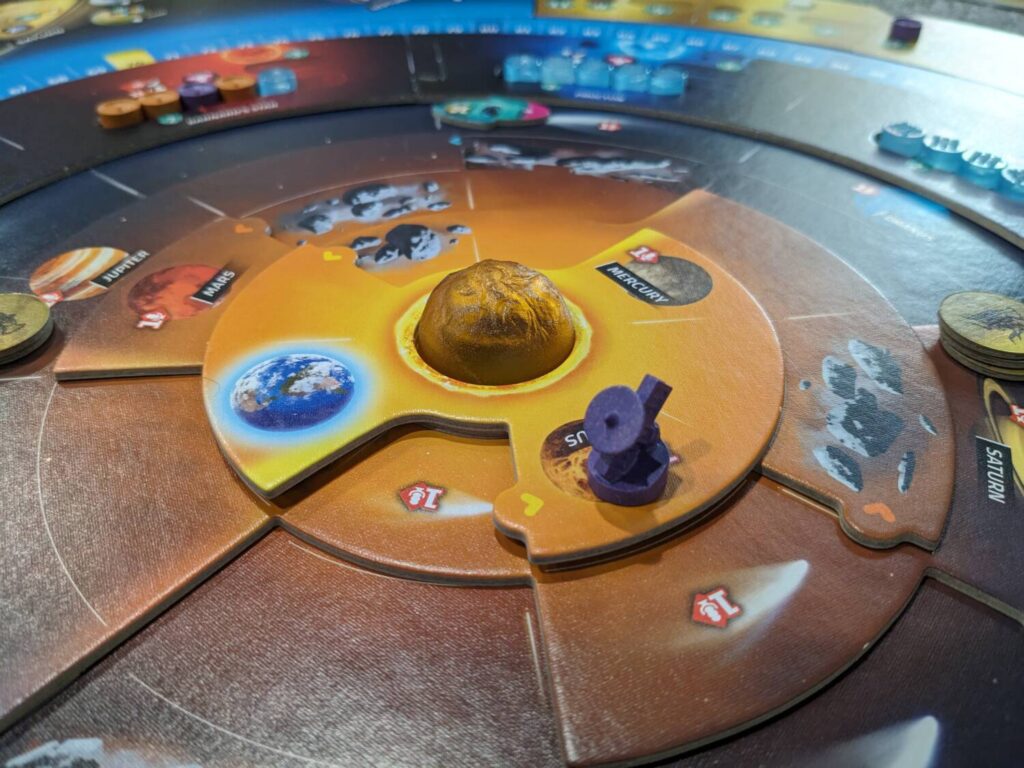
Wait for It
SETI comes alive in its third of five rounds as players round the initial elements of an engine into an alien discovery powerhouse that propels players into the stratosphere. SETI quickly reveals itself as a situationally meaty area control game, a Euro-style race to acquire the most points by landing on planets and moons, and an excellent hand management game that often requires tough choices as players spend their multi-use cards as either resources, income cards, or main action cards that often feature short- and long-term objectives for a cost.
Turns are often very quick. Players can only take one main action per turn, but before or after that main action, players can take any number of minor free actions, such as burning a card for a resource or spending energy to move a probe around the galaxy. The game’s map of space is interesting—there are planets and comets to visit, which boosts the publicity of each player tracked on a separate board, but everything in the middle of play is dictated by a four-ring map that rotates certain rings based on player actions from time to time, moving all probes within range of the ring mover.
This gives SETI a very minor but very thoughtful addition to its space exploration—timing when and where to move probes to take advantage of free movement thanks to the galaxy’s natural rhythms. Racing other players to get to a planet first yields a handsome scoring bonus, particularly because landing on a moon of a distant planet can yield a windfall that proved to be the difference in both of my multiplayer games. (Landing on a moon of Neptune or Uranus might grant someone as much as 26 points!!)
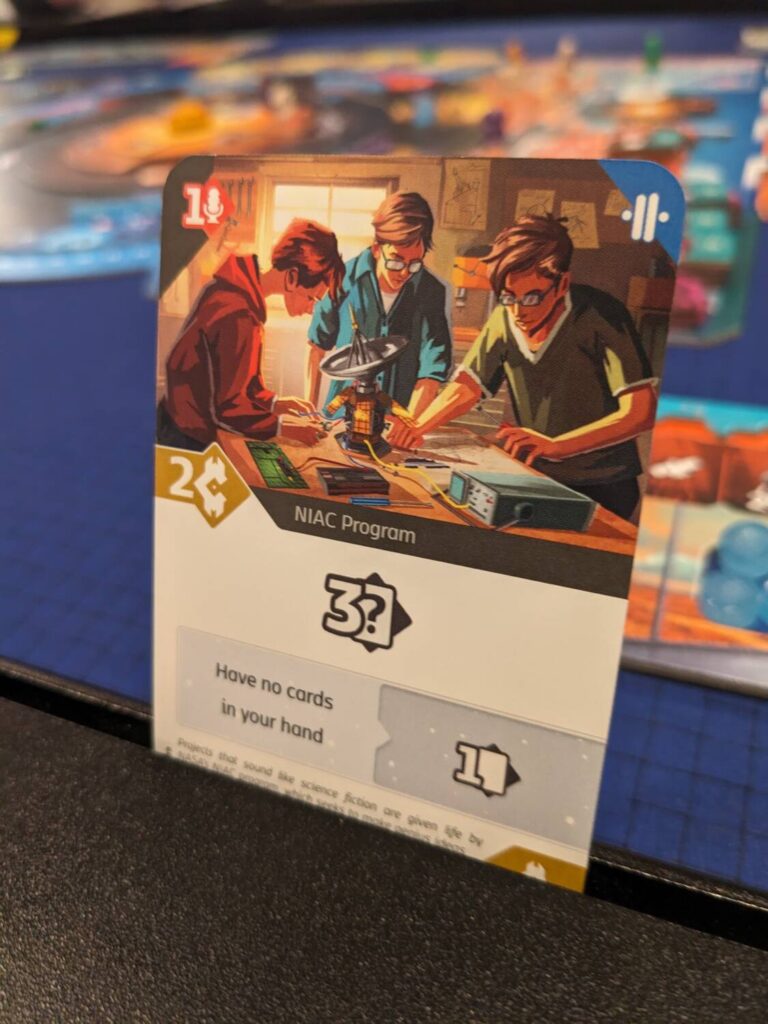
Now, if SETI was just a space race, I think I would still enjoy it because of the cardplay. Getting new cards is generally easy to do, with card bonuses all over the place—through the placement of probes as “orbiters”, racing up tracks, getting new cards during the income step, or as a bonus when acquiring new technologies. I was happily surprised with how often cards came with tough choices, knowing full well that I couldn’t keep all my cards (thanks to a four-card hand limit that is enforced when players pass for the round, or as a trading resource when you want to turn cards into credits or energy at a 2:1 rate).
And even if SETI was just a space race, I would certainly enjoy it for the gold end-game scoring milestones. Four milestones are available in each game, but players can only place a scoring disc on three of them…and a goal can only be triggered when passing 25, 50, and 70 points. That means that there is a major incentive to race as quickly as possible to score as many points as you can early on, because claiming even two of the goals’ top scoring tiers before another player can claim even one might be the difference. Player behavior was interesting around this—do I take a bonus that only grants two points and a bunch of resources, or a 10-point bonus that lets me drop my next public milestone score marker before my neighbor can?
Thankfully, SETI isn’t just a space race. One of the game’s main actions is to scan the galaxy for data, which can be inserted into the computer at the bottom of each player’s board to trigger minor bonuses and another action, Analyze. Scanning lets a player drop at least two discs in their player color in various parts of the eight data sectors of the space map. When each sector’s data area is full of player markers, the player with the most presence gets a reward that can vary from three points to much more.
Sector scans help trigger the discovery of aliens, and that’s where SETI really opened up in the third round of that first play. With vibes aligned closely with my appreciation for Shackleton Base: A Journey to the Moon, SETI has two alien factions that show up about halfway through the game that change some of the game’s rules and offers more cardplay and different ways to score points. It also kept things interesting through my first three plays because of the surprise element behind how aliens are discovered.

Those Aliens
I won’t lie, friends—if you did a demo of SETI and only played the first round or two, you really didn’t see what the game was trying to do. That’s because the aliens that players are racing to discover always showed up in my third round (of five rounds in total), and when they do, lots of fun things open up on the space map, as well as with new cards that turbocharge the action.
SETI comes with five alien factions in the box. All five are shuffled, then two are used in each game by being dealt to spaces on the west end of the planets map, face-down. When certain scoring milestones and research activity has been completed, an alien race gets discovered, which requires players to pause and learn a few new rules that augment gameplay. These can be as varied as factions that add more ways to score, to new planets that can be visited, to a pick-up-and-deliver element with a faction that requires players to transport a token back to Earth.
All the alien action is driven by new components and new cards, which add a little spice to the entire game…leaving SETI in a tough place.
The Terraforming Mars reference I made earlier? Other players made the same comment—“SETI needs a Prelude to speed things up” was a line that two different people used during my review plays. If you’ve played Terraforming Mars, then played Terraforming Mars with the Prelude expansion, you know what I mean—Terraforming Mars with Prelude isn’t necessarily shorter, but it is absolutely more interesting during its first 2-3 rounds thanks to its inclusion.
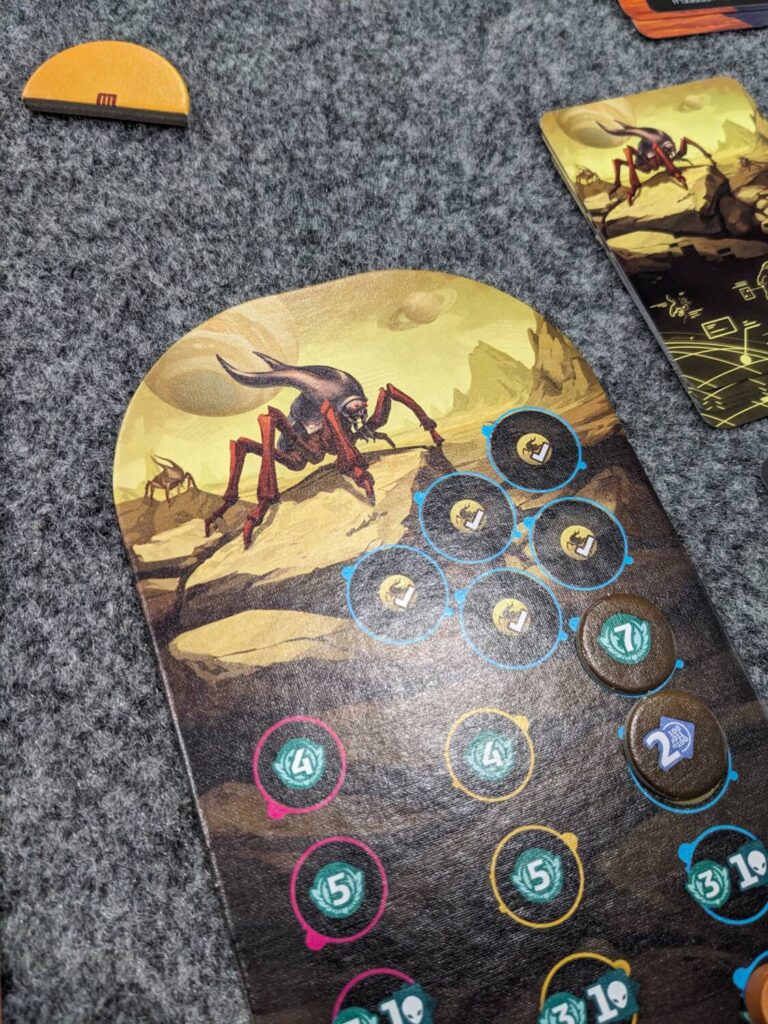
For 40% of the game, SETI feels like a game where you are always just a tad short on resources to do more than 1-2 really interesting things each round. Adding cards as income does grant the resource pictured on the card, but that is normally a card, credit or energy token, which, on their own, don’t do much of anything. One additional issue—moving around the galaxy with probes is a free action, as long as you have cards that can be burned with the movement icon pictured in the upper left-hand corner, or if you have energy that can be spent. But I’ve now seen players take just two actions in a round by buying a new probe (two credits) then moving it three spaces to a nearby planet (three energy) for one turn, then using their second turn to convert that probe into an “orbiter” for the cost of a credit and an energy, then passing for the round.
That’s not going to make a lot of players feel great. It’s important to do, sure, but it’s not the action dreams are made of.
By the third round, a player’s income might be strong enough, mixed with new actions provided by an alien species, to begin making headway on a real plan. And for that final 60% of the game, it’s a blast running around the galaxy. By then, you might have unlocked a technology that provides for not just one, but two probes to be in play at the same time. You might have a nice engine going with your space exploration, to land on both planets and juicy moons, which lead to the kinds of combos that dreams really are made of. You won’t be so light on credits, meaning that you could play 2-3 cards in the same round.
The back half of a game of SETI is so much more interesting than the front half, so plan accordingly and you’ll be just fine.
One area that I cannot fix? Player count.
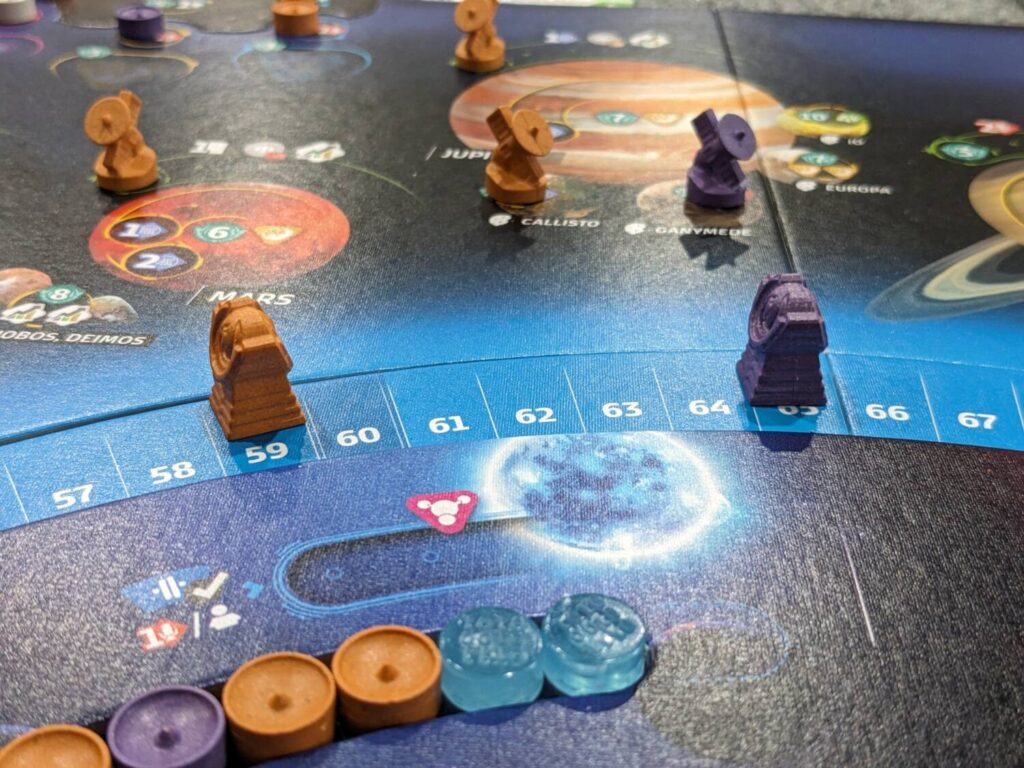
Leave a Friend or Two Behind
My two-player game of SETI—and even my solo play, which I usually don’t recommend, as a player who prefers interaction with other humans at the table—was significantly better than the four-player game.
With two players, you should be able to finish a game of SETI in under 90 minutes. Turns are generally quick, and it is almost always your turn or about to be. Keeping downtime low here is vital to enjoying the game. The game’s major discovery element is tied to the aliens, and using a clever mechanic tied to the current score, an unseen third party adds to the alien research area when a player passes 20 points when there are less than four human players. That might give aggressive players a chance to see aliens show up as soon as the second round, and there is nothing else to manage with that third party after aliens have been discovered.
With four players? I now know that SETI at the max player count is a miss. Turns are slower, as everyone has more to consider on their turns as it relates to racing to get the juiciest spots on each planet or moon. Instead of waiting 60 seconds to take a turn, you might wait 5-7 minutes, this in a game that is already a multiplayer solitaire experience. The area control elements that relate to the Scan action might be more interesting, if everyone invests in that part of the game’s design. But in my four-player game, I was the only player scanning the galaxy, so I lost out on all the game’s races to get spots on the best moon spaces (the ones that feature the single-highest scoring spaces in the game).
That also led to our belief that SETI is mostly a space exploration / orbiting / landing game, and not a data collection / scanning game. I don’t think a player who focuses only on scanning to win area control sector battles can win against players scoring 12-25 points each time they land on a moon. There’s no way I can see a player scoring 175+ points collecting data and gathering new technology tiles. (In our games, winners ended up in the 160-190 point range. The lowest score I saw was the one I had in that four-player, go-hard-on-scanning game, 116 points.)
That’s OK, but it now means that when I teach the game, I will tell players that you should spend more time focusing on landing on the moons of Neptune and Uranus, not hoping to win an area control battle in the Vega sector, which might take multiple rounds and a whole lot of luck based on the Scan mechanic.
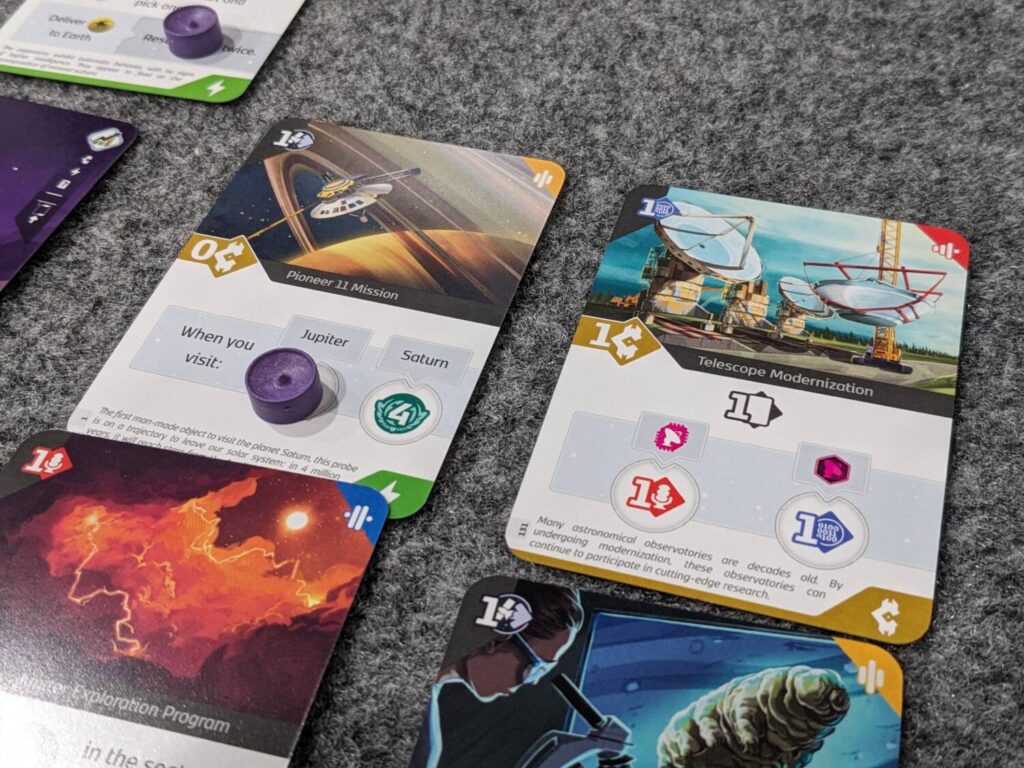
It’s Real Close
At two players, SETI: Search for Extraterrestrial Intelligence was a great time at the table, even with the slower start that came with a meh opening. That’s because the game’s individual elements are so good, particularly as you stare at your cards and recognize the value of all of them, depending on your current round’s strategy. SETI is mostly a heads-down affair, but the actions are interesting and finding the best ways to incorporate alien technologies, cards and powers is a fun puzzle, no matter which of the five alien species are in play.
With more than two players, SETI really sputtered, to the point that it was just less interesting to watch other players take actions while I waited to take turns. Even if those other players take turns as fast as I do, they are mostly in the way. Also, I was surprised that the area control portion of the game required such investment from all players to really make that shine. As it was, if only one or two players attack that part of the game’s design, it feels like a slog because of the ways sectors close out and then score for the area majority winner.
In addition to the player count issues that I had, I wish there were more ways to make the Analyze and Scan actions more viable as a majority of a player’s winning strategy. (One idea: smaller sectors, so that it would take less scanning to complete a sector. As is, it takes some sectors six scan actions to complete, and players who have invested in four of the six sections of a sector often found themselves waiting for other players to help complete those sections in order to score any points.)
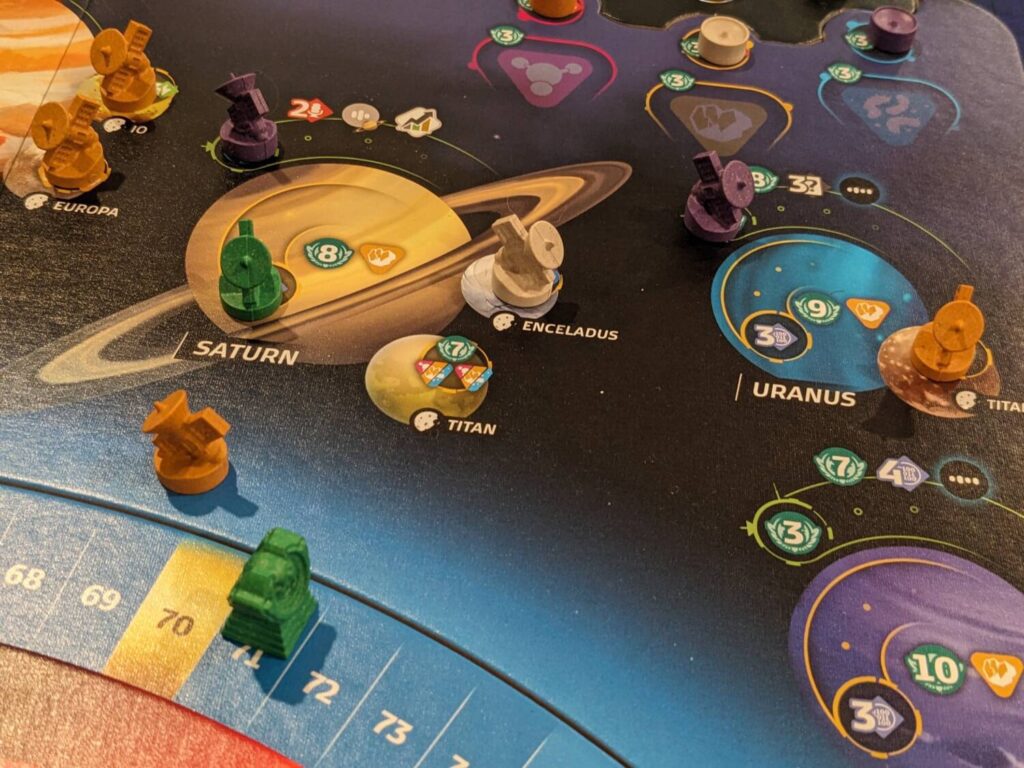
As it is, SETI pushes players to grab the scoring spaces on the most valuable moons or spaces on the alien tracks that score the most points. That also feels like the easiest way to score 200 points, a score that would almost always secure victory based on what I’ve seen in my first three games.
The solo mode is a viable option with SETI, so solo players sitting on the fence should make the leap. The solo AI is very easy to implement and there are five difficulty levels to keep that part of the game fresh. As a person who doesn’t prefer solo games, I was surprised how much more I enjoyed my solo play over the four-player one, because you always have something to do.
SETI is already ripe for expansion content. While all the game’s cards are unique, more cards never hurt anyone (thanks, Ark Nova: Marine Worlds and almost every card-driven Eurogame expansion of the last three years). More alien factions? Definitely going to happen, assuming SETI sells well for publisher CGE.
And as a production, CGE has done it again. I still think they make the best player aids in the business, and the aid for SETI might have just moved into pole position for the best I’ve seen this year. You can certainly teach the game from the aid, and every icon, end-game scoring milestone, free action, and end-of-round admin step is included. Plus, there are four aids for four players…something a few games got wrong this year.
SETI is good, and I’m going to hold onto my copy in the hopes that expansion content comes running down the street in the next year or two. It’s a good system, and now that I know where to focus my energy, I’m excited to fly up some tracks and land on some moons in the months ahead!


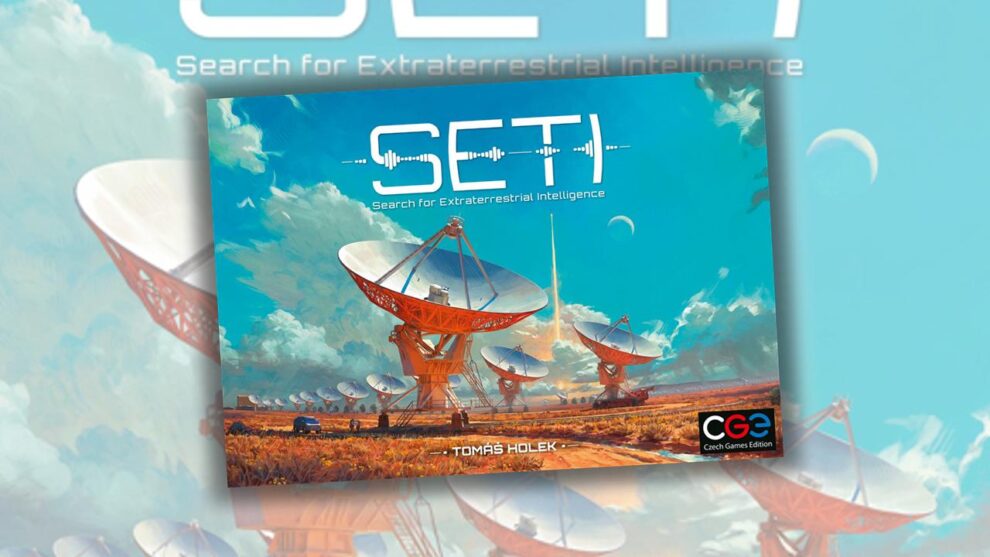









Sounds real good, shame I don´t play heavy two player games often
Hope some board games cafe in my country buy it
Great review as always Justin!
Thanks for the review, Justin! SETI is on its way to us, and we mostly play at two. Will keep your strategic notes in mind as we tackle our first play in the coming weeks.
Big fan of Justin Bell’s reviews (especially his multi-article journey through Voidfall). This is a great look at the game SETI, and correctly calls out how it doesn’t feel like it scales well to 4 players. It also highlights just how exciting things get after the “tipping point” when the engine-building gives way to big combos and big moves.
I’d strongly caution readers *against* taking the author’s strategic advice, however. Statements like “In our games, winners ended up in the 160-190 point range” betray a lack of mastery of the game’s systems (once a player is experienced, they should be shooting for a minimum of 200 in a game). The given example of a player spending a Round moving their Probe 3 spaces for 3 Energy and then Orbiting it as their entire round is certainly a possible course of action… but it’s a grossly inefficient one (that’s *far* too much energy spent for movement). Experienced players will have revealed both Alien Species by the end of Round 2 (Round 3 is much too late, for how lucrative getting their traces is). Describing “the scanning strategy” as being to weak belies a strategic misinterpretation of the game: Scanning is not “a strategy” in SETI, it’s just one action. SETI is not a game where you pick “one” strategy and just do it over and over, it’s a game where the player *must* do a bit of everything (including scanning) to achieve success. This is because of how quickly the game generates (and how quickly it takes away) *opportunities* for players (through its multitude of races and board-state-shifting effects).
To be clear, there is NOTHING WRONG with playing SETI more casually, nor is there anything wrong with not-developing
an expert-level mastery of it systems. Indeed, it’s probably the way the majority of players will play this game! Which makes this (excellent) review quite relevant to the majority of readers. I merely wish to caution readers to take the *strategic* conclusions present in the article with a (large) grain of salt.